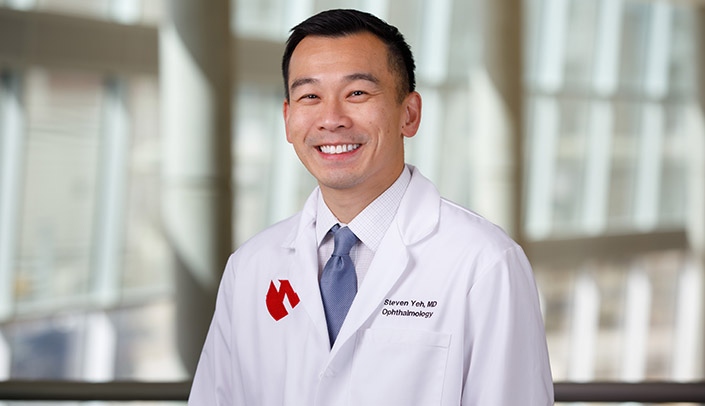Steven Yeh, MD, has always been interested in infectious disease and the immune response.
His commitment to working on treatments for infectious diseases of the eye is one reason he came to the medical center’s Truhlsen Eye Institute after a decade at Emory University in Atlanta. He was lured by the Global Center for Health Security and the National Emerging Special Pathogens Training and Education Center.
“I was drawn to the collaborative environment and also the opportunity to work with UNMC specialists in infectious disease, immunology, public health, and ophthalmology, particularly with the support of leadership within the Global Center for Health Security, which cuts across multiple disciplines” he said. “It is an opportunity to explore how we think about vision health on a global level and also understand future pandemic threats.”
The Stanley Truhlsen Jr. Endowed Chair in Ophthalmology, Dr. Yeh’s own research is on the cutting edge of uveitis treatment, studying diseases in the U.S. and more resource-limited settings.
Uveitis, a form of eye inflammation, “is a comparatively rare condition compared to other ophthalmic diseases,” Dr. Yeh said. “But the inflammation related to uveitis can be vision threatening, and there can be infectious diseases and also autoimmune diseases that can result in inflammation isolated to the eye.”
Multiple diseases of the eye have traditionally been treated with injection into the vitreous, the center of the eye. Near the end of 2021, Dr. Yeh and physicians across the U.S. who treat uveitis received word on the FDA approval on a new drug for suprachoroidal use for the treatment of macular edema associated with uveitis. (The suprachoroidal space is located between the sclera and the outer border of the choroid.) The drug was studied in the multicenter PEACHTREE Study, for which Dr. Yeh served as principal investigator.
“With higher levels of medicine that enter the space underneath the sclera, you achieve high levels of drug within the retina and the choroid and reduce medication that goes to structures within the front of the eye,” Dr. Yeh said. “These drug kinetics can improve your efficacy signals while reducing the side effects – such as cataracts and glaucoma — that can occur when steroid is concentrated in the front of the eye.”
Besides the drug itself (triamcinolone acetonide injectable suspension) being effective, the drug delivery system holds promise, Dr. Yeh said.
“There are now several different eye diseases where physicians are investigating suprachoroidal drug delivery. These include macular degeneration, diabetes or tumors of the eye,” he said. “We’re hoping that this technology will be helpful for patients with eye diseases besides uveitis in the future, as well.”
Dr. Yeh is working with promising medications in collaboration with Chris Conrady, MD, another recent UNMC ophthalmologist, to build a retina and uveitis service at TEI for patient care and research that is unique to UNMC within the Great Plains region.
Dr. Yeh also studies uveitis in Ebola survivors.
“Our research team is NIH funded for a program that looks at eye disease in Ebola survivors,” he said. “Up to 25% of individuals who survived Ebola will develop potentially blinding uveitis. Our clinical team provided care for one of the first U.S. Ebola survivors who developed sight-threatening uveitis, and we identified Ebola virus inside his eye after it had cleared the rest of his body. As a result of that finding, we studied this problem extensively and received a NIH grant for work in West Africa.”
Dr. Yeh said he is pleased to be working at TEI with Ronald Krueger, MD, the McGaw Professor and Chair and director of the Stanley Truhlsen Eye Institute.
“Dr. Krueger has a strong vision for what the Truhlsen Eye Institute can accomplish from a global ophthalmic health perspective and that aligned and resonated with what I was interested in in terms of overall mission,” he said. “With a fusion of thinking about the training platform for teaching suprachoroidal drug delivery, first in the U.S. and then potentially globally, but also learning about disease in a global health setting, the Truhlsen Eye Institute and UNMC are well-positioned to be at the forefront of cutting-edge ophthalmic work in the years ahead.”

A brilliant physician making a brilliant move. Thanks for coming to UNMC!! I hope this is the BEST decision you ever made!!
An honor to work with you!